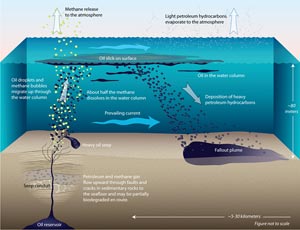Crude oil and natural gas seeps naturally out of fissures in the ocean seabed and eroding sedimentary rock. These seeps are natural springs where liquid and gaseous hydrocarbons leak out of the ground (like springs that ooze oil and gas instead of water). Whereas freshwater springs are fed by underground pools of water, oil and gas seeps are fed by natural underground accumulations of oil and natural gas (see USGS illustration). Natural oil seeps are used in identifying potential petroleum reserves.
As pointed out by the National Research Council (NRC) of the U.S. National Academy of Sciences, "natural oil seeps contribute the highest amount of oil to the marine environment, accounting for 46 per cent of the annual load to the world's oceans. -- Although they are entirely natural, these seeps significantly alter the nature of nearby marine environments. For this reason, they serve as natural laboratories where researchers can learn how marine organisms adapt over generations of chemical exposure. Seeps illustrate how dramatically animal and plant population levels can change with exposure to ocean petroleum".
NOAA describe a natural seepage area in California: "One of the best-known areas where this happens is Coal Oil Point along the California Coast near Santa Barbara. An estimated 2,000 to 3,000 gallons of crude oil is released naturally from the ocean bottom every day just a few miles offshore from this beach".

